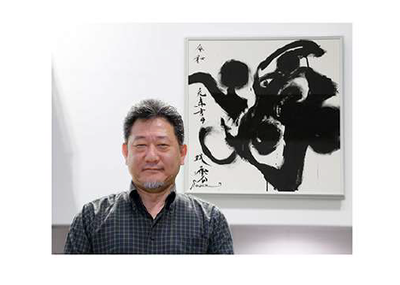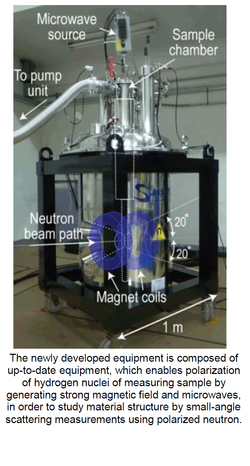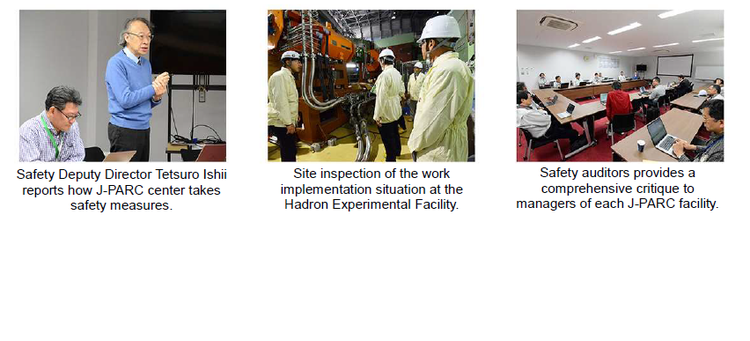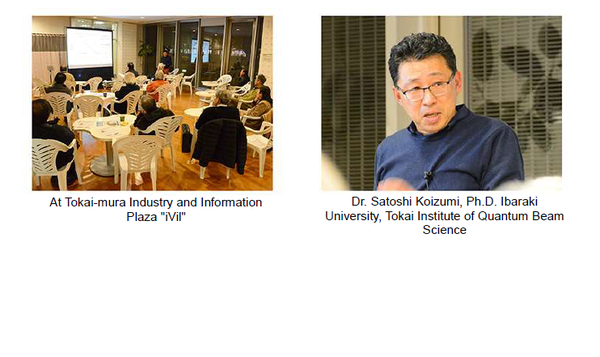J-PARC NEWS January 2020 (Issue #177)
■Entering a New Phase After 10 Years! 
I would like to thank everyone involved with J-PARC for your continued support. Here, I would like to say a word for the first issue of J-PARC News in 2020.
At the symposium commemorating our 10th anniversary last year, we invited noted scientists and the cultural anthropologist Shinichi Nakazawa, and held a panel discussion on the topic of the "Role of science in societies, role of Japan in the world." That discussion highlighted the importance not only of the science and technology that contribute to society, but also of communicating the scientific way of thinking. Academic research pioneering the frontiers of human knowledge is one pillar of J-PARC, but, at the same time, it will be increasingly important to help address issues that must be tackled at a global scale such as the climate crisis. J-PARC will be upgrading to higher beam intensity and more advanced technology this year, with initiatives like starting construction of next-generation neutrino oscillation experiments. At the same time, we will accelerate development of new battery materials, development of cooling principles employing solids, and R&D in other areas such as technology to help reduce greenhouse gases. My message for the New Year is a pledge to make even greater efforts to help more people understand the appeal of science, and the importance of scientific thinking.
Naohito Saito, Director, J-PARC Center, New Year's Day, 2020

■First Successful Selective Observation of Rubber Materials for Tires Using a Newly-Developed Quantum Beam Microscopy System — Enabling Evaluation of Products As Is, Before or After Use, with Potential Applications to Other Materials — (January 23, Press Release)
 Neutrons produced by the J-PARC accelerator are used to observe structures at the atomic level in a variety of substances. Recently, a dynamic nuclear polarization apparatus has been developed enabling selective observation that distinguishes more easily than ever before the materials on the inside of an object. For example, rubber for automobile tires is made of tens of different types of materials, and these materials form a layered structure inside the tire. Therefore, to improve tire performance, it is crucial to separately observe each of the materials inside the tire rubber, and elucidate the mechanisms of the layered structure.
Neutrons produced by the J-PARC accelerator are used to observe structures at the atomic level in a variety of substances. Recently, a dynamic nuclear polarization apparatus has been developed enabling selective observation that distinguishes more easily than ever before the materials on the inside of an object. For example, rubber for automobile tires is made of tens of different types of materials, and these materials form a layered structure inside the tire. Therefore, to improve tire performance, it is crucial to separately observe each of the materials inside the tire rubber, and elucidate the mechanisms of the layered structure.
The developed apparatus first polarizes electrons (radicals) of the material to be observed in a low-temperature environment with a high magnetic field, and then full polarization is achieved by causing polarization transfer to hydrogen using microwaves. (Aligning the direction of spins is called "polarization.") When a polarized neutron beam is injected into this material, the mode of scattering changes. Using these changes as a clue, it is possible to selectively observe the parts of the material that one wants to see. This technique eliminates the special synthesis needed with the previous method (deuterium substitution), and enables observation of the product as is.
This apparatus was developed by Professor Satoshi Koizumi, Lecturers Yohei Noda, and Tomoki Maeda at Ibaraki University to conduct small angle neutron scattering using the Ibaraki Materials Design Diffractometer (iMATERIA), a neutron beamline in Ibaraki Prefecture built by J-PARC. Going forward, there is expected to be progress in industrial utilization suited to observational needs for various materials.

■Conducted Fiscal 2019 J-PARC Center Safety Audit (December 16, J-PARC)
On December 16, the J-PARC Center Safety Audit for fiscal 2019 was conducted by two outside audit committee members specializing in safety engineering and radiation safety. In the audit, Tetsuro Ishii, Deputy Director (Safety) first explained the safety management situation in areas such as safety management of work at J-PARC, the work manager / safety leader system, and fostering safety culture. He also led a site inspection of the work implementation situation at the Hadron Experimental Facility. Next, as an example of safety management of work, neutron source section leader explained topics such as work plans, safety confirmation, and implementation results in work to replace neutron target vessels at the Materials and Life Science Experimental Facility (MLF). After the auditors heard from the managers of each J-PARC facility, they provided a comprehensive critique, emphasizing in particular the issue of passing on technologies and skills when replacing personnel, and the need to develop human resources.
■Held Fiscal 2019 Riken Symposium "Small Neutron Sources Will Transform Non-Destructive Evaluation and Analysis at Infrastructure and Manufacturing Sites" — Innovation in Element and Structure Analysis through a Combination of Large and Small — (December 19, Riken)
On December 19, the fiscal 2019 Riken Symposium was held jointly with the J-PARC Center and other organizations, and there were roughly 180 participants. At Riken, they are developing compact neutron sources usable at manufacturing and infrastructure sites, and working to improve the sophistication of neutron measurement technology exploiting the features of those beam sources. The RANS (Riken Accelerator-driven compact Neutron Source) has been operating since 2013, and in this fiscal year, Riken commenced operation of an even more compact second unit, RANS-II. Including posters, there were 28 presentations at the symposium, on topics such as the results of utilizing neutron beams produced by RANS, and steps toward practical use of compact neutron source systems. Yujiro Ikeda, former Director of the J-PARC Center (currently Special Advisor, Riken) spoke on improving performance, including development of a cold neutron moderator for RANS. In particular, he presented results of research to optimize the cold neutron source moderator which effectively led to higher performance through collaboration with related departments of J-PARC.
■Conducted Fiscal 2019 General Training for an Emergency Situation at J-PARC (January 9, MLF)
On January 9, the J-PARC Center conducted fiscal 2019 General Training for an Emergency Situation at J-PARC based on J-PARC regulations for preventing radiation hazards. The training assumed a scenario where radioactive material was abnormally released from the facility during MLF operation. The scenario started when facility managers and other key personnel were notified by a staff member who noticed something wrong with instrument readings in the MLF operation/control room. It was confirmed that there was a leak in the helium gas system producing bubbles in the target vessel mercury, and this occurred in the room for handling radioactive equipment where the neutron production target vessel is placed. The training progressed through steps such as collaboration between the accident site command post and on-site response headquarters, checking of the site, ensuring the safety of human lives, and a simulated press release.
■Held 29th J-PARC PAC (January 16-18, J-PARC)
For three days starting January 16, the J-PARC Program Advisory Committee for Nuclear and Particle Physics Experiments (J-PARC PAC) was held at the J-PARC Research Building with the attendance of 16 committee members (9 from overseas). The committee provided advice on how to proceed with planning of nuclear and particle physics research, primarily using the main ring accelerator (MR) at J-PARC, and judged new research proposal applications as joint-use experiments with universities. To begin, Naohito Saito, Director of the J-PARC Center, gave the opening message and reported on the current situation at J-PARC. Fujio Naito, Deputy Head of the Accelerator Division, reported on the current situation and future operation plan for the accelerator, and Katsuo Tokushuku, Director of KEK's Institute of Particle and Nuclear Studies explained the proposals to be judged at this PAC. Many researchers engaged in experiments at J-PARC participated in the committee's open session, and there were a total of 24 reports on topics such as the current situation and future plans for the Hadron Experimental Facility and Neutrino Experimental Facility, progress reports on experiments currently underway, and explanation of new proposal applications. Advice from the committee and the results of judging research proposals were compiled in the minutes of the PAC meeting and published.
■J-PARC Hello Science "Using Neutrons to Capture the Fleeting Moments of Bubbles" (December 20, Tokai-mura Industry and Information Plaza "iVil")
For Hello Science in December, we invited Professor Satoshi Koizumi (Graduate School of Science and Engineering, Ibaraki University) as an instructor, and he spoke on the results of research using the neutrons of the MLF to observe the function of shampoo bubbles. Dr. Koizumi gave a detailed explanation of topics such as the history in Japan of crystallography research relating to analysis of material structure, the principle of material structure analysis through observation of wave interference of quantum beams, and the current situation of quantum beam science using electron beams, synchrotron X-ray beams, and neutron beams in Ibaraki Prefecture. Dr. Koizumi concluded by pointing out that the recent experiment was carried out jointly with Nara Women's University and other institutions, using the IBARAKI Materials Design Diffractometer (iMATERIA) for product development research by manufacturers, and was able to ascertain that surfactants in shampoo play a major role in characteristics like the durability of bubbles (films). This talk presented an example of how the neutrons utilized in cutting-edge research have also been employed to develop consumer products used in our daily lives.





